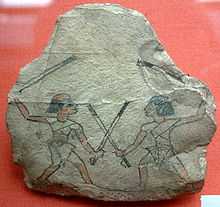Tahtib

Tahtib (Egyptian Arabic: تحطيب taḥṭīb) is the Modern Egyptian term for a traditional form of Egyptian folk dance involving a wooden stick, also known as "stick dance" or "cane dance".[1] It is sometimes also described as a "stick-dancing game", or as a highly ritualized mock fight accompanied by music.[2]
A "Nubian" form of tahtib is regularly performed for tourists in Aswan.[3]
The stick
The stick itself is about four feet in length and is called an Asa, Asaya or Assaya, or Nabboot. It is often flailed in large figure-8 patterns across the body with such speed and violence that the displacement of air is loudly discernible. There is another form practised from horseback known as “Horse Stepping” which uses a stick that is nearly 12 feet (3.7 m) long.
Performance
Although the dance form originally started as male-only, there are women who perform dressed as men and dance with other women. Another female version of stick dancing has been developed with a flirtatious and generally less aggressive style, and incorporated into cabaret or Raqs sharqi performances. The stick used for this type of dancing is generally more lightweight and hooked at one end like a cane, and generally embellished with metallic-coloured foil or sequins. The costume worn is usually folkloric: a simple Baladi dress, although Ra's el Assaya (Dance of the Stick) is often performed as part of the popularized cabaret dance set. Performance styles include balancing the cane on head, hip or shoulder.
Music
The music used in Tahtib features the tahvol (bass drum) and mizmar (folk oboe). The tahvol is a double-sided drum worn with a shoulder strap so it hangs sideways in front of the drummer and is played with two sticks. The right hand uses a heavier stick with a hooked head to beat out the "dums" which drive the heartbeat of the rhythm, while the left hand uses a light twig as a switch to produce rapid-fire staccato "taks". (Dum = the deep sound from striking the center of the drum with the right hand or with a knobbed stick; Tak = the higher sound from striking the edge of the drum with the left hand or with a light switch).
| Wikimedia Commons has media related to Tahtib. |
See also
References
- ↑ Michael B. Bakan, World music: traditions and transformations, McGraw-Hill, 2007, ISBN 978-0-07-241566-7, p. 279.
- ↑ Nicolaas H. Biegman, Egypt: moulids, saints, sufis, 1990.
- ↑ The Cities Book: A Journey Through the Best Cities in the World, Lonely Planet Publications, 2009, ISBN 978-1-74179-887-6
| |||||||||||||||||||||||||||||||||||||||||